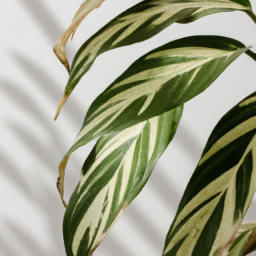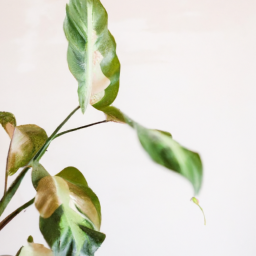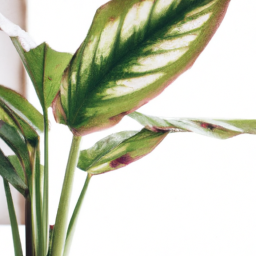
Are you looking to add a touch of greenery to your home with a tall house plant? Tall house plants can not only brighten up a room but also add a sense of tranquility and freshness to your living space. Whether you have a green thumb or are new to the world of indoor gardening, there are plenty of options to choose from when it comes to selecting the perfect tall house plant for your home. In this blog post, we will explore different types of tall house plants, their care requirements, and how to incorporate them into your home decor. So, grab your gardening gloves and let’s get started on bringing some green into your life!
Benefits of Having Tall House Plants in Your Home
Improved Air Quality
One of the main benefits of having tall house plants in your home is the improved air quality they provide. Plants are natural air purifiers, absorbing carbon dioxide and releasing oxygen through the process of photosynthesis. In addition, many house plants can remove harmful toxins from the air, such as formaldehyde and benzene, which are commonly found in household products. By having tall house plants in your home, you can breathe easier and enjoy cleaner, fresher air.
Some of the best tall house plants for improving air quality include the snake plant, spider plant, and peace lily. These plants are known for their ability to remove toxins from the air and create a healthier indoor environment. By incorporating these plants into your home decor, you can reap the benefits of cleaner air and a more pleasant living space.
In addition to purifying the air, tall house plants can also help to increase humidity levels in your home. This is especially beneficial during the dry winter months when indoor air can become too dry. By releasing moisture through their leaves, tall house plants can help to create a more comfortable and healthy indoor environment.
Enhanced Mental Well-being
Another benefit of having tall house plants in your home is the positive impact they can have on your mental well-being. Studies have shown that being around plants can reduce stress, anxiety, and depression, and improve mood and overall mental health. The presence of greenery in your home can create a sense of calm and relaxation, helping you to unwind and de-stress after a long day.
In addition, caring for tall house plants can be a rewarding and therapeutic experience. The act of watering, pruning, and tending to your plants can provide a sense of accomplishment and purpose, boosting your self-esteem and mental well-being. Watching your plants grow and thrive can also bring a sense of joy and fulfillment, enhancing your overall quality of life.
By incorporating tall house plants into your home decor, you can create a peaceful and rejuvenating sanctuary where you can escape from the stresses of daily life. Whether you place them in your living room, bedroom, or home office, tall house plants can help to create a soothing and harmonious environment that promotes mental well-being.
Improved Indoor Aesthetics
In addition to their health benefits, tall house plants can also enhance the aesthetics of your home interior. Plants add a touch of natural beauty and greenery to any space, creating a sense of warmth and vitality. Tall house plants can serve as focal points in a room, adding height, texture, and visual interest to your decor.
There are a wide variety of tall house plants to choose from, ranging from leafy palms and elegant fiddle leaf figs to dramatic dracaenas and tropical monstera plants. Whether you prefer a minimalist, modern look or a lush, jungle-inspired vibe, there is a tall house plant to suit every style and taste. By selecting plants that complement your decor and personal aesthetic, you can create a visually stunning and inviting living space.
Incorporating tall house plants into your home decor is an easy and affordable way to elevate the look and feel of your living space. Whether you have a green thumb or are new to plant care, there is a tall house plant that is perfect for you. With their numerous health benefits and aesthetic appeal, tall house plants are a must-have addition to any home.

Top Tall House Plants for Low Light Environments
Choosing the Right Tall House Plant
When it comes to selecting a tall house plant for a low light environment, there are a few key factors to consider. First and foremost, you’ll want to choose a plant that is well-suited to low light conditions. Some plants are more adaptable to low light than others, so it’s important to do your research before making a selection. Additionally, you’ll want to consider the size of the plant and how much space you have available in your home. Tall house plants can make a dramatic statement in a room, but you’ll need to make sure you have enough room for the plant to grow and thrive.
One popular option for a tall house plant in a low light environment is the snake plant, also known as mother-in-law’s tongue. Snake plants are incredibly resilient and can thrive in a variety of conditions, including low light. They are also known for their air-purifying qualities, making them a great choice for indoor spaces. Another option to consider is the peace lily, which features beautiful white flowers and glossy green leaves. Peace lilies can tolerate low light conditions, but they will thrive with a bit more natural light.
If you’re looking for a tall house plant that can add a touch of drama to your space, consider the fiddle leaf fig. This plant features large, glossy leaves that can reach impressive heights. While fiddle leaf figs prefer bright, indirect light, they can also tolerate lower light conditions. Just be sure to rotate the plant occasionally to ensure even growth. No matter which tall house plant you choose, be sure to research its specific care requirements to ensure it thrives in your home.
Caring for Your Tall House Plant
Once you’ve selected the perfect tall house plant for your low light environment, it’s important to provide the proper care to help it thrive. One of the most important factors to consider is watering. While it’s true that many house plants can tolerate lower light conditions, they still require regular watering to stay healthy. Be sure to check the soil moisture regularly and water your plant when the top inch of soil feels dry to the touch.
In addition to watering, it’s important to provide your tall house plant with the right amount of humidity. Low light environments can often be dry, which can be detrimental to some house plants. To increase humidity around your plant, consider misting it regularly or placing a humidifier nearby. You can also group plants together to create a microclimate with higher humidity.
Finally, be sure to regularly dust the leaves of your tall house plant to keep them clean and free of debris. Dust can block sunlight from reaching the plant’s leaves, which can hinder its ability to photosynthesize. Simply wipe the leaves gently with a damp cloth to remove dust and keep your plant looking its best. With proper care and attention, your tall house plant can thrive in a low light environment and bring beauty and greenery to your home.
Troubleshooting Common Issues
Even with the best care, tall house plants in low light environments can sometimes encounter issues. One common problem is yellowing leaves, which can be caused by a variety of factors including overwatering, underwatering, or nutrient deficiencies. If you notice yellowing leaves on your plant, try adjusting your watering schedule and consider fertilizing your plant to provide it with the nutrients it needs.
Another common issue with tall house plants is pest infestations. Common house plant pests include spider mites, mealybugs, and aphids, which can damage your plant if left untreated. To combat pests, try wiping down the leaves of your plant with a mild soap solution or using an insecticidal soap. You can also isolate the plant to prevent pests from spreading to other plants in your home.
If your tall house plant is struggling to thrive in a low light environment, consider moving it to a brighter location or supplementing with artificial light. While many house plants can tolerate low light conditions, they will still benefit from some natural sunlight. By troubleshooting common issues and providing your plant with the care it needs, you can help ensure that your tall house plant thrives in your home.

How to Care for Tall House Plants: Tips and Tricks
Choosing the Right Tall House Plant
When it comes to choosing a tall house plant, there are a few factors to consider. First, think about the amount of sunlight your home receives. Some tall house plants, such as the fiddle leaf fig, require bright, indirect light, while others, like the snake plant, can thrive in low light conditions. Next, consider the amount of space you have available. Make sure the plant you choose has enough room to grow tall without overcrowding the area. Additionally, think about your lifestyle and how much time you can dedicate to caring for your plant. Some tall house plants require more maintenance than others, so choose one that fits your schedule.
Once you’ve chosen the right tall house plant for your home, it’s important to provide it with the proper care to help it thrive. Watering is a crucial aspect of caring for tall house plants. Most tall house plants prefer to be watered when the top inch of soil is dry to the touch. Be sure to water your plant thoroughly, allowing the water to drain out of the bottom of the pot. Avoid overwatering, as this can lead to root rot. In addition to watering, it’s important to fertilize your tall house plant regularly to provide it with essential nutrients. Use a balanced fertilizer formulated for houseplants, and follow the instructions on the packaging for best results.
Providing the Right Environment for Your Tall House Plant
In addition to proper watering and fertilizing, it’s important to provide your tall house plant with the right environment to help it thrive. Most tall house plants prefer temperatures between 65-75 degrees Fahrenheit during the day and slightly cooler temperatures at night. Avoid placing your plant near drafty windows or heating vents, as extreme temperature fluctuations can stress the plant. Humidity is another important factor to consider when caring for tall house plants. Some plants, such as the peace lily, prefer higher humidity levels, while others, like the spider plant, can tolerate lower humidity levels. To increase humidity around your plant, you can place a humidifier nearby or mist the leaves with water.
Another key aspect of caring for tall house plants is providing them with proper support as they grow. Many tall house plants, such as the monstera deliciosa, have large leaves and heavy stems that can become top-heavy over time. To prevent your plant from leaning or falling over, use stakes or trellises to provide support. You can also rotate your plant regularly to ensure even growth on all sides. Pruning is another important maintenance task for tall house plants. Remove any dead or yellowing leaves, as well as any leggy growth, to promote new growth and maintain the plant’s overall health.
Common Issues and Troubleshooting Tips
Despite your best efforts, you may encounter some common issues when caring for tall house plants. One common problem is pests, such as spider mites or mealybugs, which can infest your plant and cause damage. To prevent pests, regularly inspect your plant for any signs of infestation, such as webbing or sticky residue on the leaves. If you do find pests, treat your plant with insecticidal soap or neem oil to eliminate them. Another issue you may encounter is yellowing or browning leaves, which can be caused by overwatering, underwatering, or nutrient deficiencies. To troubleshoot this problem, adjust your watering schedule, fertilize your plant, and ensure it is receiving adequate sunlight.
In conclusion, caring for tall house plants requires attention to detail and a proactive approach to maintenance. By choosing the right plant for your home, providing it with the proper care and environment, and troubleshooting any issues that arise, you can enjoy a thriving and beautiful tall house plant in your living space. Remember to be patient and observant, as each plant is unique and may require individualized care. With these tips and tricks in mind, you can successfully care for your tall house plants and watch them grow and flourish in your home.
In Summary
Are you looking to bring some greenery into your home but don’t have much floor space to spare? Consider adding a tall house plant to your indoor decor! Tall house plants are a great way to add a touch of nature to your space without taking up valuable square footage. These plants can help to create a sense of height and drama in a room, making it feel more spacious and inviting.
Some popular tall house plant options include the fiddle leaf fig, snake plant, and rubber plant. These plants are not only visually appealing but also have air-purifying qualities, helping to improve the air quality in your home. With the right care and maintenance, a tall house plant can thrive indoors and bring a touch of the outdoors inside. So why not add a tall house plant to your home and enjoy the benefits of having a green companion that adds beauty and freshness to your living space?
Top FAQs:
Q1: What are some popular tall house plants?
A1: Some popular tall house plants include the fiddle leaf fig, rubber plant, snake plant, and bird of paradise. These plants are known for their height and ability to thrive indoors.
Q2: How tall do house plants typically grow?
A2: The height of house plants can vary depending on the species. Some tall house plants can grow up to 6 feet or more, while others may stay shorter. It’s important to research the specific plant you are interested in to determine its potential height.
Q3: What are some tips for caring for tall house plants?
A3: To care for tall house plants, make sure they are placed in a spot with adequate sunlight, water them regularly (but be careful not to overwater), and occasionally dust their leaves to keep them healthy. It’s also important to repot them as they grow to ensure they have enough space for their roots.
Q4: Can tall house plants help improve indoor air quality?
A4: Yes, tall house plants can help improve indoor air quality by absorbing carbon dioxide and releasing oxygen through photosynthesis. Some house plants can also help remove toxins from the air, making your indoor environment healthier.
Q5: Are tall house plants suitable for beginners?
A5: Yes, many tall house plants are suitable for beginners, as long as you choose a species that matches your level of experience and commitment to care for them. Some tall house plants are more forgiving of occasional neglect, while others may require more attention. Start with an easy-to-care-for plant if you are new to indoor gardening.
Emily Bloomfield is an interior designer and horticulturist specializing in incorporating indoor plants into interior spaces. With a background in both design and plant science, Emily offers a unique perspective on creating harmonious living environments through the synergy of greenery and aesthetics. Her creative ideas and innovative solutions make her a sought-after authority in the field.


